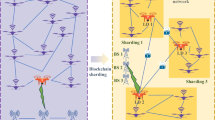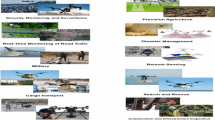Abstract
Sharding is a promising technique to tackle the critical weakness of scalability in blockchain-based unmanned aerial vehicle (UAV) search and rescue (SAR) systems. By breaking up the blockchain network into smaller partitions called shards that run independently and in parallel, sharding-based UAV systems can support a large number of search and rescue UAVs with improved scalability, thereby enhancing the rescue potential. However, the lack of adaptability and interoperability still hinder the application of sharded blockchain in UAV SAR systems. Adaptability refers to making adjustments to the blockchain towards real-time surrounding situations, while interoperability refers to making cross-shard interactions at the mission level. To address the above challenges, we propose a blockchain UAV system for SAR missions based on dynamic sharding mechanism. Apart from the benefits in scalability brought by sharding, our system improves adaptability by dynamically creating configurable and mission-exclusive shards, and improves interoperability by supporting calls between smart contracts that are deployed on different shards. We implement a prototype of our system based on Quorum, give an analysis of the improved adaptability and interoperability, and conduct experiments to evaluate the performance. The results show our system can achieve the above goals and overcome the weakness of blockchain-based UAV systems in SAR scenarios.
Similar content being viewed by others
Explore related subjects
Discover the latest articles and news from researchers in related subjects, suggested using machine learning.References
Su Z, Wang Y, Xu Q, Zhang N. LVBS: lightweight vehicular blockchain for secure data sharing in disaster rescue. IEEE Transactions on Dependable and Secure Computing, 2022, 19(1): 19–32
Wang Y, Su Z, Xu Q, Li R, Luan T H. Lifesaving with RescueChain: energy-efficient and partition-tolerant blockchain based secure information sharing for UAV-aided disaster rescue. In: Proceedings of the IEEE International Conference on Computer Communications. 2021, 1–10.
Wang Y, Su Z, Xu Q, Li R, Luan T H, Wang P. A secure and intelligent data sharing scheme for UAV-assisted disaster rescue. IEEE/ACM Transactions on Networking, 2023, 31(6): 2422–2438
Nguyen T, Katila R, Gia T N. An advanced internet-of-drones system with blockchain for improving quality of service of search and rescue: a feasibility study. Future Generation Computer Systems, 2023, 140: 36–52
Gai K, Wu Y, Zhu L, Choo K K R, Xiao B. Blockchain-enabled trustworthy group communications in UAV networks. IEEE Transactions on Intelligent Transportation Systems, 2021, 22(7): 4118–4130
Xu H, Huang W, Zhou Y, Yang D, Li M, Han Z. Edge computing resource allocation for unmanned aerial vehicle assisted mobile network with blockchain applications. IEEE Transactions on Wireless Communications, 2021, 20(5): 3107–3121
Jiang L, Chen B, Xie S, Maharjan S, Zhang Y. Incentivizing resource cooperation for blockchain empowered wireless power transfer in UAV networks. IEEE Transactions on Vehicular Technology, 2020, 69(12): 15828–15841
Mehta P, Gupta R, Tanwar S. Blockchain envisioned UAV networks: challenges, solutions, and comparisons. Computer Communications, 2020, 151: 518–538
Xie J, Yu F R, Huang T, Xie R, Liu J, Liu Y. A survey on the scalability of blockchain systems. IEEE Network, 2019, 33(5): 166–173
Tong W, Dong X, Shen Y, Jiang X, Zhang Z. A blockchain-driven data exchange model in multi-domain IoT with controllability and parallelity. Future Generation Computer Systems, 2022, 135: 85–94
Tong W, Dong X, Shen Y, Jiang X. A hierarchical sharding protocol for multi-domain IoT blockchains. In: Proceedings of the IEEE International Conference on Communications (ICC). 2019, 1–6.
Hashim F, Shuaib K, Sallabi F. MedShard: electronic health record sharing using blockchain sharding. Sustainability, 2021, 13(11): 5889
Al-Bassam M, Sonnino A, Bano S, Hrycyszyn D, Danezis G. Chainspace: a sharded smart contracts platform. In: Proceedings of the Network and Distributed System Security Symposium (NDSS). 2018
Alkadi R, Alnuaimi N, Yeun C Y, Shoufan A. Blockchain interoperability in unmanned aerial vehicles networks: state-of-the-art and open issues. IEEE Access, 2022, 10: 14463–14479
Wu Y, Dai H N, Wang H, Choo K K R. Blockchain-based privacy preservation for 5G-enabled drone communications. IEEE Network, 2021, 35(1): 50–56
Qian Y, Jiang Y, Hu L, Hossain M S, Alrashoud M, Al-Hammadi M. Blockchain-based privacy-aware content caching in cognitive internet of vehicles. IEEE Network, 2020, 34(2): 46–51
Xiao W, Li M, Alzahrani B, Alotaibi R, Barnawi A, Ai Q. A blockchain-based secure crowd monitoring system using UAV swarm. IEEE Network, 2021, 35(1): 108–115
Islam A, Shin S Y. BUAV: a blockchain based secure UAV-assisted data acquisition scheme in internet of things. Journal of Communications and Networks, 2019, 21(5): 491–502
Kanade V A. Securing drone-based Ad Hoc network using blockchain. In: Proceedings of the IEEE International Conference on Artificial Intelligence and Smart Systems (ICAIS). 2021, 1314–1318.
Yazdinejad A, Parizi R M, Dehghantanha A, Karimipour H, Srivastava G, Aledhari M. Enabling drones in the internet of things with decentralized blockchain-based security. IEEE Internet of Things Journal, 2021, 8(8): 6406–6415
Nguyen T, Katila R, Gia T N. A novel internet-of-drones and blockchain-based system architecture for search and rescue. In: Proceedings of the 18th International Conference on Mobile Ad Hoc and Smart Systems (MASS). 2021, 278–288.
Masuduzzaman M, Islam A, Rahim T, Shin S Y. Blockchain-assisted UAV-employed casualty detection scheme in search and rescue mission in the internet of battlefield things. In: Proceedings of the International Conference on Information and Communication Technology Convergence (ICTC). 2020, 412–416.
Wang J, Wang H. Monoxide: scale out blockchain with asynchronous consensus zones. In: Proceedings of the 16th USENIX Symposium on Networked Systems Design and Implementation (NSDI 19). 2019, 95–112.
Kwon J, Buchman E. Cosmos whitepaper. See Github.com/cosmos/cosmos/blob/master/WHITEPAPER.md website, 2019
Wood G. Polkadot: vision for a heterogeneous multi-chain framework. See Assets.polkadot.network/Polkadot-whitepaper.pdf website, 2016
Hong Z, Guo S, Li P, Chen W. Pyramid: a layered sharding blockchain system. In: Proceedings of the IEEE International Conference on Computer Communications (INFOCOM). 2021, 1–10.
Luu L, Narayanan V, Zheng C, Baweja K, Gilbert S, Saxena P. A secure sharding protocol for open blockchains. In: Proceedings of the ACM SIGSAC Conference on Computer and Communications Security. 2016, 17–30.
Kokoris-Kogias E, Jovanovic P, Gasser L, Gailly N, Syta E, Ford B. OmniLedger: a secure, scale-out, decentralized ledger via sharding. In: Proceedings of the IEEE Symposium on Security and Privacy (SP). 2018, 583–598.
Khakurel U, Rawat D, Njilla L. FastChain: lightweight blockchain with sharding for internet of battlefield-things in NS-3. In: Proceedings of the IEEE International Conference on Industrial Internet (ICII). 2019, 241–247.
Doku R, Rawat D B, Garuba M, Njilla L. Fusion of named data networking and blockchain for resilient internet-of-battlefield-things. In: Proceedings of the 17th Annual Consumer Communications & Networking Conference (CCNC). 2020, 1–6.
Ghimire B, Rawat D B, Liu C, Li J. Sharding-enabled blockchain for software-defined internet of unmanned vehicles in the battlefield. IEEE Network, 2021, 35(1): 101–107
Golam M, Akter R, Naufal R, Doan V S, Lee J M, Kim D S. Blockchain inspired intruder UAV localization using lightweight CNN for internet of battlefield things. In: Proceedings of the IEEE Military Communications Conference (MILCOM). 2022, 342–349.
Wang G, Shi Z J, Nixon M, Han S. SoK: sharding on blockchain. In: Proceedings of the 1st ACM Conference on Advances in Financial Technologies. 2019, 41–61.
Zhang G, Pan F, Mao Y, Tijanic S, Dang’ana M, Motepalli S, Zhang S, Jacobsen H A. Reaching consensus in the byzantine empire: a comprehensive review of BFT consensus algorithms. ACM Computing Surveys, 2024, 56(5): 134
Morgan J. Quorum whitepaper. New York: JP Morgan Chase, 2016
Doku R, Rawat D B, Garuba M, Njilla L. LightChain: on the lightweight blockchain for the internet-of-things. In: Proceedings of the IEEE International Conference on Smart Computing. 2019, 444–448.
Pongnumkul S, Siripanpornchana C, Thajchayapong S. Performance analysis of private blockchain platforms in varying workloads. In: Proceedings of the 26th International Conference on Computer Communication and Networks (ICCCN). 2017, 1–6.
Kuzlu M, Pipattanasomporn M, Gurses L, Rahman S. Performance analysis of a hyperledger fabric blockchain framework: throughput, latency and scalability. In: Proceedings of 2019 IEEE International Conference on Blockchain (Blockchain). 2019, 536–540.
Acknowledgements
This work was supported by the National Key R&D Program of China (2022YFB2703200) and the National Natural Science Foundation of China (Grant Nos. 62202011, 62172010).
Author information
Authors and Affiliations
Corresponding author
Ethics declarations
Competing interests The authors declare that they have no competing interests or financial conflicts to disclose.
Additional information
Xihan Zhang received his BE degree in computing science from Beijing University of Post and Telecommunication, China in 2022. He is currently working toward a MS degree in Peking University, China. His main research interests include blockchain, software engineering and privacy.
Jiashuo Zhang received the BE degree in computer science from Peking University, China in 2021. He is currently a PhD student in the School of Computer Science, Peking University, China. His research interests include blockchain and software engineering.
Jianbo Gao received the BE and PhD degrees in computer science from Peking University, China in 2016 and 2021, respectively. He is currently working as a postdoctoral researcher with the School of Computer Science, Peking University, China. His research interests include blockchain, software engineering, and cyber security.
Libin Xia received his BE degree in Information Security from Shanghai Jiao Tong University, China in 2022. He is currently working toward a MS degree in Peking University, China. His main research interests include blockchain, smart contracts and privacy.
Zhi Guan received the PhD degree in computer science from Peking University, China in 2009, He has been a faculty member of the MoE (Ministry of Education) Key Laboratory of Network and Software Security Assurance, Peking University and National Engineering Research Center of Software Engineering of Peking University since 2009. He is an associate professor and his current research interests include cryptography and blockchain.
Hao Hu received the PhD degree in computer science from Nanjing University, China in 2009. He joined the State Key Laboratory for Novel Software Technology and the Institute of Computer Software at Nanjing University, China in 2000. He is an associate professor and his current research interests include blockchain, swarm intelligence and Internetware.
Zhong Chen graduated and received the PhD degree from Computer Science and Technology Department of Peking University, China in 1989, and became a faculty member of Peking University, China. He became a full professor in 1995. He is a professor of the School of Computer Science with Peking University, and the director of Metaverse Technology Institite, director of Network and Information Security Laboratory of Peking University, China. His current research interests include blockchain, domain-specific software engineering, network and information security.
Electronic supplementary material
Rights and permissions
About this article
Cite this article
Zhang, X., Zhang, J., Gao, J. et al. A sharding blockchain-based UAV system for search and rescue missions. Front. Comput. Sci. 19, 193805 (2025). https://doi.org/10.1007/s11704-024-3467-8
Received:
Accepted:
Published:
DOI: https://doi.org/10.1007/s11704-024-3467-8




